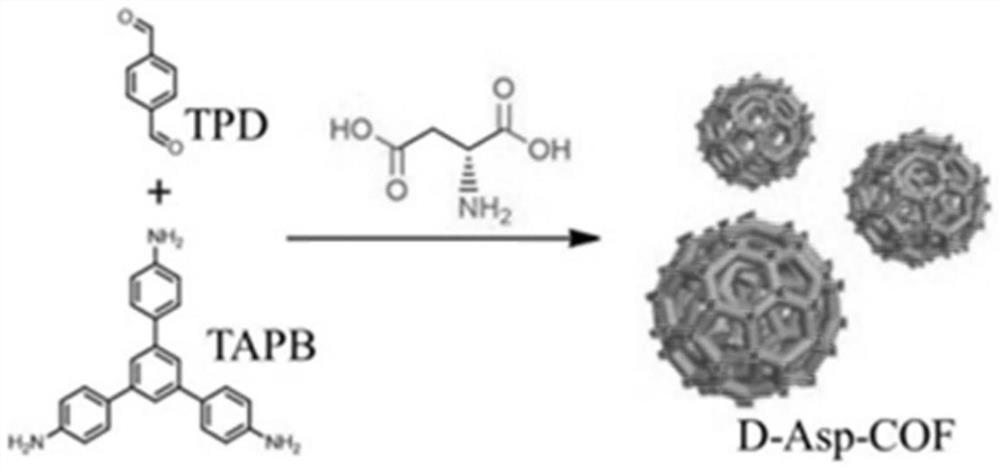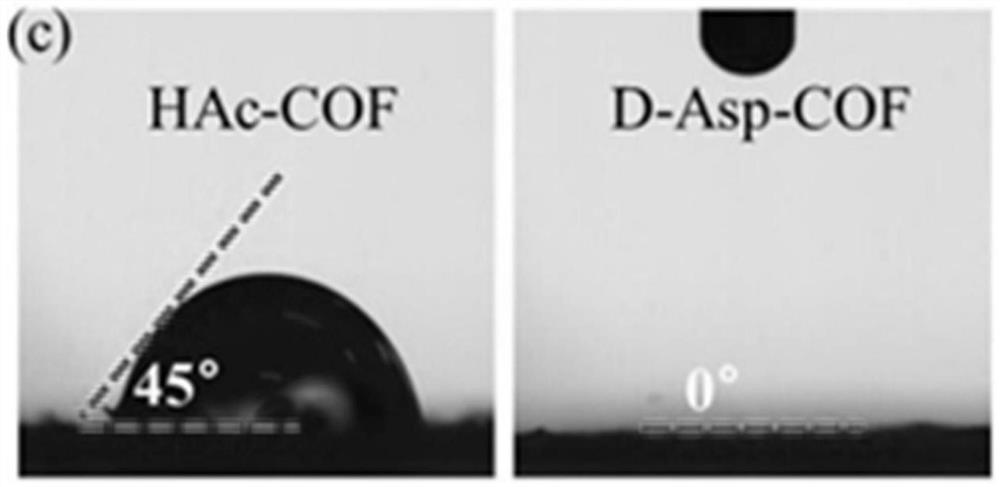Nanometer spherical covalent organic framework as well as preparation method and application of nanometer spherical covalent organic framework with controllable particle size
A covalent organic framework, spherical technology, applied in the direction of nanotechnology, nanotechnology, nanomedicine, etc., can solve the problems of underdevelopment, cumbersome multi-step sequence, hindering biomedical applications, etc., and achieve the effect of simplifying synthesis
- Summary
- Abstract
- Description
- Claims
- Application Information
AI Technical Summary
Problems solved by technology
Method used
Image
Examples
Embodiment 1
[0044] This example provides a nano-spherical covalent organic framework, which achieves both size control and surface functionalization of COF NPs through an aspartic acid (Asp)-assisted synthesis method, such as figure 1 shown. The raw materials for its synthesis are 1,3,5-tris(4-aminophenyl)benzene (TAPB) and terephthalic acid (TPD).
[0045] Its concrete preparation method is:
[0046] 0.04 M D-Asp aqueous solution was added to ACN (1.5 mL) in TAPB (0.04 mmol) and TPD (0.06 mmol) solution, and a yellow amorphous solid was precipitated immediately at room temperature.
[0047] Then the precipitated yellow amorphous solid was centrifuged at 6000rpm for 10min, washed with ACN, and oven-dried at 60°C for 30min to obtain a powder sample nano-spherical covalent organic framework (D-Asp-COF).
[0048] The prepared D-Asp-COF was subjected to transmission electron microscopy, and its image was as follows Figure 4 , Figure 5 As shown in the scanning electron microscope, the imag...
Embodiment 2
[0050] In this example, the traditional use of acetic acid (HAv) as a catalyst, the prepared nano-spherical covalent organic framework was used as the control group, and the D-Asp-COF prepared above was used as the experimental group to test the water dispersibility and hydrophilicity:
[0051] In the control group, nanospherical covalent organic frameworks were prepared as follows:
[0052] The reaction raw materials 1,3,5-tris(4-aminophenyl)benzene (TAPB) and terephthalic acid (TPD) were placed in acetonitrile (ACN) / HAc system at room temperature for 10s, through the condensation reaction of reversible imine bonds , the yellow amorphous solid HAc-COF spheres were obtained.
[0053] Inspection process:
[0054] Stable HAc-COF and D-Asp-COF nanoparticle suspensions prepared under the same procedure, the two suspensions were placed under the same change and observed.
[0055] Test results such as figure 2 , the HAc-COF suspension started to precipitate after one day, while ...
Embodiment 3
[0058] This example is based on the preparation method of D-Asp-COF provided in Example 1, and the experiment of controlling its particle size is carried out:
[0059] (1) Change the batch feeding times of D-Asp (n times feeding, each round 1 / n, interval 10min) to control the particle size of D-Asp-cof balls. Preparation of D-Asp-COF spheres (TAPB: 16mM, 1mL; TPD: 24mM, 1mL LD-Asp (0.04M, 2.4mL) reacted for 200min to obtain 70nm COF spheres.
[0060] (2) Change the feeding speed: divided into one-time feeding and intermittent feeding, such as twice, three times, four times, etc. to control the feeding speed. Depending on the batch added, two growth modes were observed: growth of existing particles and nucleation of new particles.
[0061] (3) Change the initial monomer concentration: under the same conditions as other experiments, adjust the initial monomer concentration to control the particle size. When the amount of D-Asp increased from 1 equivalent to 4 equivalents, the ...
PUM
 Login to View More
Login to View More Abstract
Description
Claims
Application Information
 Login to View More
Login to View More - R&D
- Intellectual Property
- Life Sciences
- Materials
- Tech Scout
- Unparalleled Data Quality
- Higher Quality Content
- 60% Fewer Hallucinations
Browse by: Latest US Patents, China's latest patents, Technical Efficacy Thesaurus, Application Domain, Technology Topic, Popular Technical Reports.
© 2025 PatSnap. All rights reserved.Legal|Privacy policy|Modern Slavery Act Transparency Statement|Sitemap|About US| Contact US: help@patsnap.com



